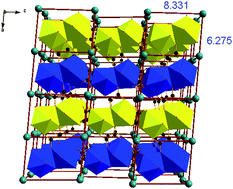A family of 3D metal–organic frameworks Na2Ln2(ox)3(suc)·(H2O)2, (Ln = Nd 1, Eu 2, Gd 3, Tb 4, ox = oxalate, suc = succinate) have been hydrothermally synthesized by self-assembly of succinic, sodium oxalate and Ln3+. They were characterized by X-ray crystallography, revealing that they crystallize in monoclinic groupP21/c. Ln3+ cations adopt a 9-fold configuration. Ox ligands play a unique dual role. These salts bear extraordinary structural features which result from host–guest interactions. Ln3+ cations, ox anions and succinate anions construct a host 3D framework. Guest Na+ cations are connected by ox ligands to construct a 3D alkali metal guest lattice, which is incorporated in the host 3D framework. Na+ cations adopt a fairly rare 7-fold configuration. The host–guest interaction would be more evident when sodium oxalate is displaced by oxalic acid, leading to an open framework [Nd2(ox)(suc)2·(H2O)4]·4H2O (5), where Nd3+ cations are 8-fold. Complex 5 bears a layer-pillared 3D structure, orthorhombic groupFddd, distinct from that of complex 1. Their thermal behavior, luminescence properties, and magnetic properties have been studied.


 Please wait while we load your content...
Please wait while we load your content...